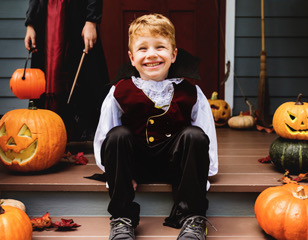 Halloween, with its costumes, parties, and spooky decorations, is a joyous occasion for most children. However, for those with Sensory Processing Disorder (SPD), the festivities can become overwhelming. Children with SPD interpret sensory inputs in unique ways, often making what’s pleasurable for others discomforting. While costumes may seem exciting, they can feel itchy, makeup might be sticky, and masks may trigger strong scents or feelings of confinement.
Halloween, with its costumes, parties, and spooky decorations, is a joyous occasion for most children. However, for those with Sensory Processing Disorder (SPD), the festivities can become overwhelming. Children with SPD interpret sensory inputs in unique ways, often making what’s pleasurable for others discomforting. While costumes may seem exciting, they can feel itchy, makeup might be sticky, and masks may trigger strong scents or feelings of confinement.
As a mother of a child with SPD, I intimately understand the challenges that Halloween presents. Daily struggles to find comfortable clothing are a part of my daughter’s routine. If we discover a pair of pants she approves, I stock up as much as possible. Loud noises and unfamiliar situations frequently lead to stress.
Despite her desire to participate in Halloween fun, the mounting pressure as the day approaches often becomes too much. The discomfort of the costume and the prospect of knocking on strangers’ doors after dark can be frightening. This cycle of frustration for me and disappointment for her is one that we’re determined to break. This year, we’re taking a fresh approach.
Here are some valuable tips for families like ours, striving to make Halloween an enjoyable experience for children with Sensory Processing Disorder.
Preparation is Key
Before the Halloween excitement begins, engage your child in a conversation about the upcoming festivities. Discuss potential challenges and explore comfort zones. If traditional trick-or-treating feels intimidating, consider practicing by having your child knock on the doors of friends, neighbors, or family members beforehand. Familiarity can alleviate anxiety. Take time to try on the costume well in advance, making any necessary alterations to ensure your child’s comfort.
Thoughtful Costume Choices
Costumes might seem like a hurdle for children with SPD, but various alternatives can cater to their needs. My daughter, for instance, prefers her favorite clothes and enjoys face paint. Others might find solace in wearing soft pajamas under their costumes to counteract itchiness. If your child isn’t keen on dressing up, think creatively. Decorate a wagon and allow your child to ride in it as an enjoyable option. Simple ideas like incorporating props, wearing a humorous t-shirt, or integrating tools like noise-canceling headphones into the costume also helps.
Anticipate Challenges
Having a backup plan is crucial in case things don’t go as envisioned. Despite my daughter’s initial enthusiasm and her decision to wear a costume to school, the actual trick-or-treating experience with her siblings was overwhelming. It’s essential to accept that your child might need to take breaks or decide to stay home and distribute candy instead. Flexibility is key. Explore daytime Halloween activities or fall events with a milder atmosphere, where wearing costumes is optional. Consider seeking out local family-friendly events that align with your child’s comfort level, such as those highlighted in San Diego Family’s compilation of Halloween Happenings and Fall Activities.
Halloween can be fun for children with SPD when family members work together to create traditions that are comfortable for everyone. Consider painting pumpkins, baking treats, or going to dinner or a movie. With a little planning, practice and flexibility, Halloween can be enjoyable for the whole family.
Sarah Lyons is a freelance writer and mom of a child with Sensory Processing Disorder.
Leave a Reply